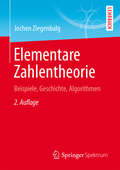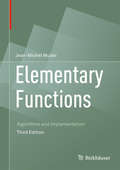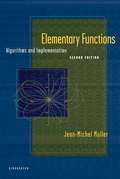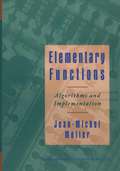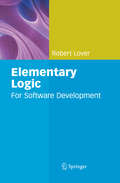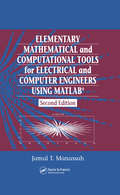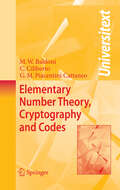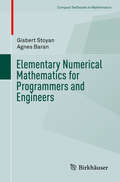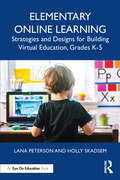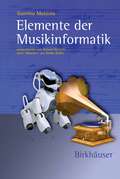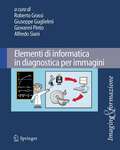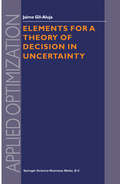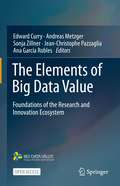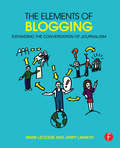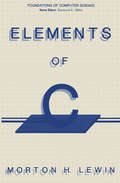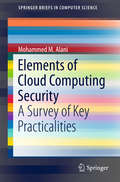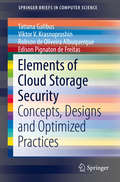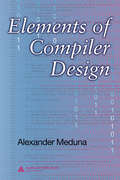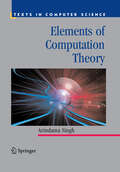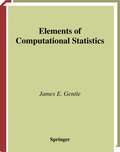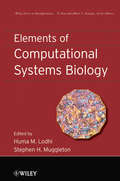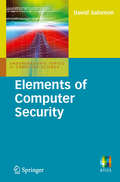- Table View
- List View
Elementare Zahlentheorie: Beispiele, Geschichte, Algorithmen
by Jochen ZiegenbalgDieses Buch bietet einen historisch orientierten Einstieg in die elementare Zahlentheorie. Es stellt eine solide Basis für vielfältige Ausbaumöglichkeiten dar. Besondere Zielsetzungen sind: Elementarität und Anschaulichkeit, die Berücksichtigung der historischen Entwicklung, Motivation der Begriffe und Verfahren anhand konkreter, aussagekräftiger Beispiele unter Einbezug moderner Werkzeuge (Computeralgebra Systeme, Internet). Als Zusatzmedien werden Computer- und Internet-spezifische Interaktions- und Visualisierungsmöglichkeiten (kostenlos) zur Verfügung gestellt. Das Werk wendet sich an Studierende (Bachelor/Lehramt), Lehrer(innen) sowie alle an Elementarmathematik interessierten Leser.
Elementary Functions: Algorithms and Implementation
by Jean-Michel MullerThis textbook presents the concepts and tools necessary to understand, build, and implement algorithms for computing elementary functions (e.g., logarithms, exponentials, and the trigonometric functions). Both hardware- and software-oriented algorithms are included, along with issues related to accurate floating-point implementation. This third edition has been updated and expanded to incorporate the most recent advances in the field, new elementary function algorithms, and function software.After a preliminary chapter that briefly introduces some fundamental concepts of computer arithmetic, such as floating-point arithmetic and redundant number systems, the text is divided into three main parts. Part I considers the computation of elementary functions using algorithms based on polynomial or rational approximations and using table-based methods; the final chapter in this section deals with basic principles of multiple-precision arithmetic. Part II is devoted to a presentation of “shift-and-add” algorithms (hardware-oriented algorithms that use additions and shifts only). Issues related to accuracy, including range reduction, preservation of monotonicity, and correct rounding, as well as some examples of implementation are explored in Part III. Numerous examples of command lines and full programs are provided throughout for various software packages, including Maple, Sollya, and Gappa. New to this edition are an in-depth overview of the IEEE-754-2008 standard for floating-point arithmetic; a section on using double- and triple-word numbers; a presentation of new tools for designing accurate function software; and a section on the Toom-Cook family of multiplication algorithms.The techniques presented in this book will be of interest to implementers of elementary function libraries or circuits and programmers of numerical applications. Additionally, graduate and advanced undergraduate students, professionals, and researchers in scientific computing, numerical analysis, software engineering, and computer engineering will find this a useful reference and resource.PRAISE FOR PREVIOUS EDITIONS“[T]his book seems like an essential reference for the experts (which I'm not). More importantly, this is an interesting book for the curious (which I am). In this case, you'll probably learn many interesting things from this book. If you teach numerical analysis or approximation theory, then this book will give you some good examples to discuss in class." — MAA Reviews (Review of Second Edition)"The rich content of ideas sketched or presented in some detail in this book is supplemented by a list of over three hundred references, most of them of 1980 or more recent. The book also contains some relevant typical programs." — Zentralblatt MATH (Review of Second Edition)“I think that the book will be very valuable to students both in numerical analysis and in computer science. I found [it to be] well written and containing much interesting material, most of the time disseminated in specialized papers published in specialized journals difficult to find." — Numerical Algorithms (Review of First Edition)
Elementary Functions: Algorithms and Implementation
by Jean-Michel MullerSecond Edition of successful, well-reviewed Birkhauser book, which sold 866 copies in North America Provides an up-to-date presentation by including new results, examples, and problems throughout the text The second edition adds a chapter on multiple-precision arithmetic, and new algorithms invented since 1997
Elementary Functions: Algorithms and Implementation
by Jean-Michel MullerSecond Edition of successful, well-reviewed Birkhauser book, which sold 866 copies in North America Provides an up-to-date presentation by including new results, examples, and problems throughout the text The second edition adds a chapter on multiple-precision arithmetic, and new algorithms invented since 1997
Elementary Logic: For Software Development
by Robert LoverThe ability to reason correctly is critical to most aspects of computer science and to software development in particular. This book teaches readers how to better reason about software development, to communicate reasoning, to distinguish between good and bad reasoning, and to read professional literature that presumes knowledge of elementary logic. The reader’s knowledge and understanding can be assessed through numerous examples and exercises. This book provides a reader-friendly foundation to logic and offers valuable insight into the topic, thereby serving as a helpful reference for practitioners, as well as students studying software development.
Elementary Mathematical and Computational Tools for Electrical and Computer Engineers Using MATLAB
by Jamal T. ManassahEngineers around the world depend on MATLAB for its power, usability, and outstanding graphics capabilities. Yet too often, engineering students are either left on their own to acquire the background they need to use MATLAB, or they must learn the program concurrently within an advanced course. Both of these options delay students from solving realistic design problems, especially when they do not have a text focused on applications relevant to their field and written at the appropriate level of mathematics.Ideal for use as a short-course textbook and for self-study Elementary Mathematical and Computational Tools for Electrical and Computer Engineers Using MATLAB fills that gap. Accessible after just one semester of calculus, it introduces the many practical analytical and numerical tools that are essential to success both in future studies and in professional life. Sharply focused on the needs of the electrical and computer engineering communities, the text provides a wealth of relevant exercises and design problems. Changes in MATLAB's version 6.0 are included in a special addendum.The lack of skills in fundamental quantitative tools can seriously impede progress in one's engineering studies or career. By working through this text, either in a lecture/lab environment or by themselves, readers will not only begin mastering MATLAB, but they will also hone their analytical and computational skills to a level that will help them to enjoy and succeed in subsequent electrical and computer engineering pursuits.
Elementary Mathematical and Computational Tools for Electrical and Computer Engineers Using MATLAB
by Jamal T. ManassahEngineers around the world depend on MATLAB for its power, usability, and outstanding graphics capabilities. Yet too often, engineering students are either left on their own to acquire the background they need to use MATLAB, or they must learn the program concurrently within an advanced course. Both of these options delay students from solving realistic design problems, especially when they do not have a text focused on applications relevant to their field and written at the appropriate level of mathematics.Ideal for use as a short-course textbook and for self-study Elementary Mathematical and Computational Tools for Electrical and Computer Engineers Using MATLAB fills that gap. Accessible after just one semester of calculus, it introduces the many practical analytical and numerical tools that are essential to success both in future studies and in professional life. Sharply focused on the needs of the electrical and computer engineering communities, the text provides a wealth of relevant exercises and design problems. Changes in MATLAB's version 6.0 are included in a special addendum.The lack of skills in fundamental quantitative tools can seriously impede progress in one's engineering studies or career. By working through this text, either in a lecture/lab environment or by themselves, readers will not only begin mastering MATLAB, but they will also hone their analytical and computational skills to a level that will help them to enjoy and succeed in subsequent electrical and computer engineering pursuits.
Elementary Number Theory, Cryptography and Codes (Universitext)
by M. Welleda Baldoni Ciro Ciliberto G.M. Piacentini CattaneoIn this volume one finds basic techniques from algebra and number theory (e.g. congruences, unique factorization domains, finite fields, quadratic residues, primality tests, continued fractions, etc.) which in recent years have proven to be extremely useful for applications to cryptography and coding theory. Both cryptography and codes have crucial applications in our daily lives, and they are described here, while the complexity problems that arise in implementing the related numerical algorithms are also taken into due account. Cryptography has been developed in great detail, both in its classical and more recent aspects. In particular public key cryptography is extensively discussed, the use of algebraic geometry, specifically of elliptic curves over finite fields, is illustrated, and a final chapter is devoted to quantum cryptography, which is the new frontier of the field. Coding theory is not discussed in full; however a chapter, sufficient for a good introduction to the subject, has been devoted to linear codes. Each chapter ends with several complements and with an extensive list of exercises, the solutions to most of which are included in the last chapter. Though the book contains advanced material, such as cryptography on elliptic curves, Goppa codes using algebraic curves over finite fields, and the recent AKS polynomial primality test, the authors' objective has been to keep the exposition as self-contained and elementary as possible. Therefore the book will be useful to students and researchers, both in theoretical (e.g. mathematicians) and in applied sciences (e.g. physicists, engineers, computer scientists, etc.) seeking a friendly introduction to the important subjects treated here. The book will also be useful for teachers who intend to give courses on these topics.
Elementary Numerical Mathematics for Programmers and Engineers (Compact Textbooks in Mathematics)
by Gisbert Stoyan Agnes BaranThis book covers the basics of numerical methods, while avoiding the definition-theorem-proof style and instead focusing on numerical examples and simple pseudo-codes.The book is divided into ten chapters. Starting with floating number calculations and continuing up to ordinary differential equations, including "Euler backwards". The final chapter discusses practical error estimations. Exercises (including several in MATLAB) are provided at the end of each chapter. Suitable for readers with minimal mathematical knowledge, the book not only offers an elementary introduction to numerical mathematics for programmers and engineers but also provides supporting material for students and teachers of mathematics.
Elementary Online Learning: Strategies and Designs for Building Virtual Education, Grades K-5
by Lana Peterson Holly SkadsemElementary Online Learning offers school- and district-level leaders and administrators a field-tested approach to developing formal and interdisciplinary online education, in-house and from scratch, for grades K-5. While it is possible today to purchase off-the-shelf online platforms from for-profit companies, many elementary schools have the option of creating their own programs, curricula, and instructional strategies that are deliberately tailored to the strengths and needs of their own communities. This book provides practical and effective approaches to cohesive, data-driven program design, synchronous and asynchronous teaching, professional development, family partnerships, and much more. Each chapter is full of research-based ideas, recommendations, and prompts that will help schools yield online education that is interdisciplinary, socially just, and student-driven.
Elementary Online Learning: Strategies and Designs for Building Virtual Education, Grades K-5
by Lana Peterson Holly SkadsemElementary Online Learning offers school- and district-level leaders and administrators a field-tested approach to developing formal and interdisciplinary online education, in-house and from scratch, for grades K-5. While it is possible today to purchase off-the-shelf online platforms from for-profit companies, many elementary schools have the option of creating their own programs, curricula, and instructional strategies that are deliberately tailored to the strengths and needs of their own communities. This book provides practical and effective approaches to cohesive, data-driven program design, synchronous and asynchronous teaching, professional development, family partnerships, and much more. Each chapter is full of research-based ideas, recommendations, and prompts that will help schools yield online education that is interdisciplinary, socially just, and student-driven.
Elemente der Musikinformatik
by Guerino MazzolaDieses Lehrbuch stellt eine Einführung in die noch junge Disziplin der Musikinformatik dar. Es beginnt mit einer Übersicht über die gegenwärtige Entwicklung der Musik aus der Wechselwirkung zwischen Technologie und Komposition. Darauf aufbauend werden Kodierung und Programmierung musikalischer Objekte für Komposition, Analyse und Interpretation besprochen, sowie Standards und Darstellungsmethoden, wie: MIDI, Musik-N, Fourier, FM, Wavelets, Physical Modeling und Denotatoren. Eine vertiefte Diskussion erfährt dabei der FFT-Algorithmus und natürlich das Kompressionsverfahren MP3. Anschließend werden Plattformen für die computergestützte Analyse, Komposition und Interpretation vorgestellt, darunter RUBATO, MAX und Presto. Darauf folgt eine Einführung in Methoden der Navigation im Begriffsraum der Musik. Abschließend wird die Perspektive einer verteilten globalen Musikkultur diskutiert, wie sie sich etwa durch den iPod, sowie Internet-basierte Musikdistribution, -produktion und -komposition abzeichnet.
Elementi di informatica in diagnostica per immagini (Imaging & Formazione #1)
by Roberto Grassi Giuseppe Guglielmi Giovanni Pinto Alfredo SianiIl volume nasce dall’esperienza acquisita dagli autori con le lezioni svolte nel corso di laurea in Tecniche Radiologiche per Immagini e Radioterapia. I contenuti sono articolati in quattro parti principali - il Sistema e l’Hardware, il Software, Macchine Evolute, Pratica e Applicazioni - e i singoli capitoli sono arricchiti da curiosità e approfondimenti allo scopo di sollecitare l’attenzione del lettore a fini didattici. Con la stessa finalità nel testo si alternano concetti formativi, specialistici e squisitamente professionali, come le reti neurali, a richiami storici sulla evoluzione dei sistemi di calcolo. Stile e linguaggio sono spesso volutamente orientati alla rapida comprensione e facile assimilazione di argomenti anche complessi, più che al rigore strettamente formale. Il lettore potrà infine valutare il proprio grado di apprendimento eseguendo i test di autoverifica strutturati con il metodo "multiple choice". Il volume rappresenta pertanto un efficace strumento educativo per i tecnici di radiologia medica come pure un utile riferimento per gli operatori che usino quotidianamente procedure informatiche nelle strutture sanitarie presso le quali svolgono la loro professione.
Elements for a Theory of Decision in Uncertainty (Applied Optimization #32)
by Jaime Gil-AlujaDecisions in uncertainty Scientific reaction to change During latter decades, the basic elements that have traditionally made up the society in wh ich economic activity develops, have been submitted to the effect of multiple aggressions as a consequence of the outcome of events motivated by the nature itself of the human being, always seeking a level of happiness that is never reached. In a very brief manner we are accustomed to mention these by using words such as revolution, profound changes, convulsions . . . . , the results of which are manifest through non-linear reactions that lead to a future charged with uncertainty. To get to know, explain and treat this new world constitutes one of the many objectives of those who desire a society in the service of man, and for those who aspire to the fact of the concept of mutuality transcending the use less limits of the printed word. But for this it will be necessary to overcome a whole realm of obstacles placed in the way by those comfortably embedded in old principles, decrepit ideas and are not willing to open the windows of their mind to receive the fresh air of a new era.
The Elements of Big Data Value: Foundations of the Research and Innovation Ecosystem
by Edward Curry Andreas Metzger Sonja Zillner Jean-Christophe Pazzaglia Ana García RoblesThis open access book presents the foundations of the Big Data research and innovation ecosystem and the associated enablers that facilitate delivering value from data for business and society. It provides insights into the key elements for research and innovation, technical architectures, business models, skills, and best practices to support the creation of data-driven solutions and organizations. The book is a compilation of selected high-quality chapters covering best practices, technologies, experiences, and practical recommendations on research and innovation for big data. The contributions are grouped into four parts: · Part I: Ecosystem Elements of Big Data Value focuses on establishing the big data value ecosystem using a holistic approach to make it attractive and valuable to all stakeholders. · Part II: Research and Innovation Elements of Big Data Value details the key technical and capability challenges to be addressed for delivering big data value. · Part III: Business, Policy, and Societal Elements of Big Data Value investigates the need to make more efficient use of big data and understanding that data is an asset that has significant potential for the economy and society. · Part IV: Emerging Elements of Big Data Value explores the critical elements to maximizing the future potential of big data value. Overall, readers are provided with insights which can support them in creating data-driven solutions, organizations, and productive data ecosystems. The material represents the results of a collective effort undertaken by the European data community as part of the Big Data Value Public-Private Partnership (PPP) between the European Commission and the Big Data Value Association (BDVA) to boost data-driven digital transformation.
The Elements of Blogging: Expanding the Conversation of Journalism
by Mark Leccese Jerry LansonBecoming a blogger takes practice, hard work, and, ultimately, a passion for the craft. Whether you plan to blog on politics or parenting, The Elements of Blogging is designed to give you the skills and strategies to get started, to sustain your work, and to seek out a robust audience. This book is loaded with practical advice on important topics such as determining a niche, finding the best stories, and blogging effectively and ethically. It features examples from both amateur and professional bloggers that show the techniques for building an argument, finding a voice, crafting a headline, and establishing a brand. Key features: Real-world applicability. This book includes thumbnail profiles of bloggers and their sites, which illuminate key skills you will need to become an effective blogger Interactivity. Each chapter features discussion points and exercises intended to get you to think about, reflect on, and apply the contents of each chapter Creativity. While this book dives into software and plug-ins for bloggers, its main goal is to cover how to write blogs on a myriad of topics: news, opinion pieces, travel, politics, art, and more. Visit the companion website: http://www.theelementsofblogging.com/
The Elements of Blogging: Expanding the Conversation of Journalism
by Mark Leccese Jerry LansonBecoming a blogger takes practice, hard work, and, ultimately, a passion for the craft. Whether you plan to blog on politics or parenting, The Elements of Blogging is designed to give you the skills and strategies to get started, to sustain your work, and to seek out a robust audience. This book is loaded with practical advice on important topics such as determining a niche, finding the best stories, and blogging effectively and ethically. It features examples from both amateur and professional bloggers that show the techniques for building an argument, finding a voice, crafting a headline, and establishing a brand. Key features: Real-world applicability. This book includes thumbnail profiles of bloggers and their sites, which illuminate key skills you will need to become an effective blogger Interactivity. Each chapter features discussion points and exercises intended to get you to think about, reflect on, and apply the contents of each chapter Creativity. While this book dives into software and plug-ins for bloggers, its main goal is to cover how to write blogs on a myriad of topics: news, opinion pieces, travel, politics, art, and more. Visit the companion website: http://www.theelementsofblogging.com/
Elements of C (Foundations of Computer Science)
by Morton H. LewinStatements in C, like statements in any other programming language, consist almost entirely of expressions and special reserved words. Declarations in C, unlike declarations in other languages, also contain arbitrary expressions. Thus, studying the means by which C expressions are constructed and evaluated is especially important-particularly since the number of permissible C operators is so large. Since all of the operands in a C expression (excluding constants) must be properly declared before they are used, and since declarations themselves contain expressions, the teaching of C involves the following chicken-and-egg problem: Should one begin by considering only elementary declarations, in which case the topic of expression construction and evaluation cannot be fully treated in one place, because the operators that pertain to the more complex objects-like pointers and structures (whose declarations have not yet been introduced)--have not yet been covered, or should one postpone entirely the issue of how decla rations are written (merely assuming that all of the objects under discussion have been properly declared) in order to fully treat all types of operands and operators in one comprehensive discussion? If the student is encouraged to begin writing programs immediately, the former choice is mandatory, because even the most elementary programs must vII Preface viii contain proper declarations. Thus, most C textbooks postpone the discussion of objects like arrays, structures, and pointers (and of the operators that pertain to them) until the second half of the book is reached.
Elements of Cloud Computing Security: A Survey of Key Practicalities (SpringerBriefs in Computer Science)
by Mohammed M. AlaniThis book offers a thorough yet easy-to-read reference guide to various aspects of cloud computing security. It begins with an introduction to the general concepts of cloud computing, followed by a discussion of security aspects that examines how cloud security differs from conventional information security and reviews cloud-specific classes of threats and attacks. A range of varying threats in cloud computing are covered, from threats of data loss and data breaches, to threats to availability and threats posed by malicious insiders. Further, the book discusses attacks launched on different levels, including attacks on the hypervisor, and on the confidentiality of data. Newer types, such as side-channel attacks and resource-freeing attacks, are also described. The work closes by providing a set of general security recommendations for the cloud.
Elements of Cloud Storage Security: Concepts, Designs and Optimized Practices (SpringerBriefs in Computer Science)
by Tatiana Galibus Viktor V. Krasnoproshin Robson de Oliveira Albuquerque Edison Pignaton de FreitasThis work provides guidelines for the practical implementation of security architecture in a particular corporate cloud. The authors are mathematicians and specialists in data modeling and security. Experience of scientific collaboration with industry inspired the authors to attempt to conceptualize the common processes and strategies in cloud security, in order to make security system deployment as simple and transparent as possible. The deployment is broken into several essential steps that allow the functionality of security architecture for any cloud to be split into a set of modules. The continuous verification of security support on all levels (data, processes and communication channels) helps to avoid common security breaches and protect against the most dangerous attacks. Additionally, performing the proposed optimization of the selected set of mechanisms will enhance the efficiency of the security system.
Elements of Compiler Design
by Alexander MedunaMaintaining a balance between a theoretical and practical approach to this important subject, Elements of Compiler Design serves as an introduction to compiler writing for undergraduate students. From a theoretical viewpoint, it introduces rudimental models, such as automata and grammars, that underlie compilation and its essential phases. Based on
Elements of Computation Theory (Texts in Computer Science)
by Arindama SinghThe foundation of computer science is built upon the following questions: What is an algorithm? What can be computed and what cannot be computed? What does it mean for a function to be computable? How does computational power depend upon programming constructs? Which algorithms can be considered feasible? For more than 70 years, computer scientists are searching for answers to such qu- tions. Their ingenious techniques used in answering these questions form the theory of computation. Theory of computation deals with the most fundamental ideas of computer s- ence in an abstract but easily understood form. The notions and techniques employed are widely spread across various topics and are found in almost every branch of c- puter science. It has thus become more than a necessity to revisit the foundation, learn the techniques, and apply them with con?dence. Overview and Goals This book is about this solid, beautiful, and pervasive foundation of computer s- ence. It introduces the fundamental notions, models, techniques, and results that form the basic paradigms of computing. It gives an introduction to the concepts and mathematics that computer scientists of our day use to model, to argue about, and to predict the behavior of algorithms and computation. The topics chosen here have shown remarkable persistence over the years and are very much in current use.
Elements of Computational Statistics (Statistics and Computing)
by James E. GentleWill provide a more elementary introduction to these topics than other books available; Gentle is the author of two other Springer books
Elements of Computational Systems Biology (Wiley Series in Bioinformatics #8)
by Huma M. Lodhi Stephen H. MuggletonGroundbreaking, long-ranging research in this emergent field that enables solutions to complex biological problems Computational systems biology is an emerging discipline that is evolving quickly due to recent advances in biology such as genome sequencing, high-throughput technologies, and the recent development of sophisticated computational methodologies. Elements of Computational Systems Biology is a comprehensive reference covering the computational frameworks and techniques needed to help research scientists and professionals in computer science, biology, chemistry, pharmaceutical science, and physics solve complex biological problems. Written by leading experts in the field, this practical resource gives detailed descriptions of core subjects, including biological network modeling, analysis, and inference; presents a measured introduction to foundational topics like genomics; and describes state-of-the-art software tools for systems biology. Offers a coordinated integrated systems view of defining and applying computational and mathematical tools and methods to solving problems in systems biology Chapters provide a multidisciplinary approach and range from analysis, modeling, prediction, reasoning, inference, and exploration of biological systems to the implications of computational systems biology on drug design and medicine Helps reduce the gap between mathematics and biology by presenting chapters on mathematical models of biological systems Establishes solutions in computer science, biology, chemistry, and physics by presenting an in-depth description of computational methodologies for systems biology Elements of Computational Systems Biology is intended for academic/industry researchers and scientists in computer science, biology, mathematics, chemistry, physics, biotechnology, and pharmaceutical science. It is also accessible to undergraduate and graduate students in machine learning, data mining, bioinformatics, computational biology, and systems biology courses.
Elements of Computer Security (Undergraduate Topics in Computer Science)
by David SalomonAs our society grows ever more reliant on computers, so it also becomes more vulnerable to computer crime. Cyber attacks have been plaguing computer users since the 1980s, and computer security experts are predicting that smart telephones and other mobile devices will also become the targets of cyber security threats in the future. Developed from the author's successful Springer guide to Foundations of Computer Security, this accessible textbook/reference is fully updated and enhanced with resources for students and tutors. Topics and features: examines the physical security of computer hardware, networks, and digital data; introduces the different forms of rogue software (or malware), discusses methods for preventing and defending against malware, and describes a selection of viruses, worms and Trojans in detail; investigates the important threats to network security, and explores the subjects of authentication, spyware, and identity theft; discusses issues of privacy and trust in the online world, including children's privacy and safety; includes appendices which discuss the definition, meaning, and history of the term hacker, introduce the language of "l33t Speak", and provide a detailed virus timeline; provides numerous exercises and examples throughout the text, in addition to a Glossary of terms used in the book; supplies additional resources at the associated website, http://www.DavidSalomon.name/, including an introduction to cryptography, and answers to the exercises. Clearly and engagingly written, this concise textbook is an ideal resource for undergraduate classes on computer security. The book is mostly non-mathematical, and is suitable for anyone familiar with the basic concepts of computers and computations.
